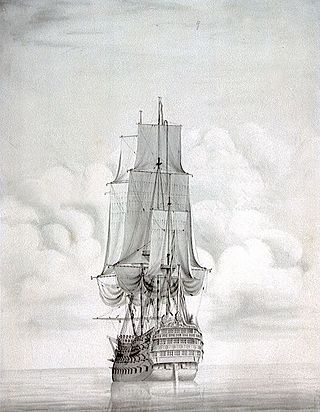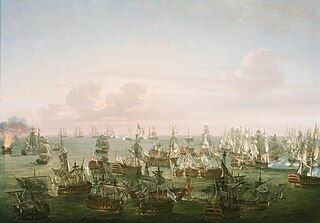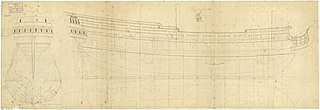
HMS Vanguard was a 90-gun second-rate ship of the line of the Royal Navy, built at Portsmouth Dockyard and launched in 1678.

HMS Mars was a 74-gun third-rate ship of the line of the Royal Navy, launched on 25 October 1794 at Deptford Dockyard.

HMS Barfleur was a 90-gun second-rate ship of the line of the Royal Navy, designed by Sir Thomas Slade on the lines of the 100-gun ship Royal William, and launched at Chatham Dockyard on 30 July 1768, at a cost of £49,222. In about 1780, she had another eight guns added to her quarterdeck, making her a 98-gun ship; she possessed a crew of approximately 750. Her design class sisters were the Prince George, Princess Royal, and Formidable. She was a ship of long service and many battles.

HMS Royal Oak was a 74-gun third-rate ship of the line of the Royal Navy, built by Jonas Shish at Deptford and launched in 1674. She was one of only three Royal Navy ships to be equipped with the Rupertinoe naval gun. Life aboard her when cruising in the Mediterranean Sea in 1679 is described in the diary of Henry Teonge.

HMS Britannia was a 120-gun first-rate ship-of-the-line of the Royal Navy, laid down in 1813 and launched on 20 October 1820.

HMS Northumberland was a 74-gun third-rate ship of the line of the Royal Navy, built at the yards of Barnard, Deptford and launched on 2 February 1798. She carried Napoleon to his final exile on St Helena.

HMS Valiant was a 70-gun third rate ship of the line of the Royal Navy, modelled on the captured French ship Invincible and launched on 1 August 1759 at Chatham Dockyard. Her construction, launch and fitting-out are the theme of the 'Wooden Walls' visitor experience at Chatham Historic Dockyard. She served under Augustus Keppel during the Seven Years' War, and was with him at the Capture of Havana, in 1763.
HMS Ramillies was a 74-gun third rate ship of the line of the Royal Navy, launched on 12 July 1785 at Rotherhithe. However, it was not actually commissioned by the Navy until February 1793. Its first Captain was Henry Harvey.

HMS Diadem was a 64-gun third rate ship of the line of the Royal Navy, launched on 19 December 1782 at Chatham. She participated in the Battle of Cape St Vincent in 1797 under Captain George Henry Towry.

The Caledonia-class ships of the line were a class of nine 120-gun first rates, designed for the Royal Navy by Sir William Rule. A tenth ship was ordered on 29 October 1827 to the same design, but was launched in 1833 as Queen to a fresh design by Sir William Symonds.

HMS Trafalgar was a 120-gun first-rate ship of the line of the Royal Navy, launched on 21 June 1841 at Woolwich Dockyard. HMS Trafalgar was the last ship to complete the successful Caledonia class.

HMS Prince was a 100-gun first rate ship of the line of the Royal Navy, built by Phineas Pett the Younger at Deptford Dockyard and launched in 1670.

HMS Royal Sovereign was a 100-gun first rate ship of the line of the Royal Navy, built at Woolwich Dockyard and launched in July 1701. She had been built using some of the salvageable timbers from the previous Royal Sovereign, which had been destroyed by fire in 1697.

HMS Wellesley was a 74-gun third rate, named after the Duke of Wellington, and launched in 1815. She captured Karachi for the British, and participated in the First Opium War, which resulted in Britain gaining control of Hong Kong. Thereafter she served primarily as a training ship before gaining the distinction of being the last British ship of the line to be sunk by enemy action and the only one to have been sunk by an air-raid.

HMS Black Prince was a 74-gun third rate ship of the line of the Black Prince class of the Royal Navy, launched on 30 March 1816 at Woolwich Dockyard.

HMS Falkland was a 50-gun fourth-rate ship of the line of the Royal Navy, built by Holland of New Castle, New Hampshire, and purchased by the navy in 1696.

HMS Kingston was a 60-gun fourth-rate ship of the line of the Royal Navy, built by Frame in Hull and launched on 13 March 1697. She had an eventful career, taking part in numerous engagements.
HMS Triumph was a 90-gun second rate ship of the line of the Royal Navy, launched at Chatham Dockyard on 2 March 1697. She was renamed HMS Prince in 1714.
HMS Tilbury was a 60-gun fourth-rate ship of the line of the Royal Navy, built at Chatham Dockyard to the dimensions of the 1719 Establishment, and launched on 2 June 1733.

HMS Victor Emmanuel was a screw-propelled 91-gun second-rate ship of the line of the Royal Navy, originally launched as HMS Repulse, but renamed shortly after being launched.

















